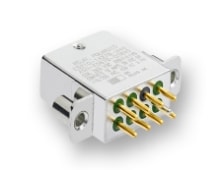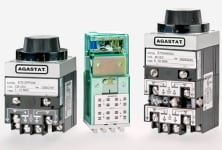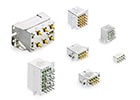A relay is an electronically operated switch that is remotely activated by an electromagnet which pulls a set of contacts to either make or break a circuit.
Electrical relays are commonly used for switching signals, radio frequencies, high current circuits when using a lower current circuit, and loads such as resistive, motor, lamp, inductive, and capacitive applications. This is helpful when an in-line switch or existing circuit does not have the capacity to handle the required current.
At TE, we manufacture one of the broadest ranges of relay types, including latching (bi-stable) relays and non-latching (monostable) relays, plug-in relays, and reed relays. Our electromechanical relays are engineered for – among many other applications – electrical isolation, controlling power in manufacturing and transportation applications, and for switching smaller current values in a control circuit, such as in building automation technology and control panels. Relays serve as an amplifier.
Relays by Brand
Our electromechanical relays are manufactured by our brands, including
Electromagnetic relays and electronic relays
An electromagnetic relay can be classified according to the nature of the intermediate signal between the primary side and the switching element. A magnetic field generated by the input signal operates on the mechanical contacts. Examples include the standard yoke type relay and the reed relay. This standard yoke type of relay consists of a wire coil that is wrapped around a soft iron core, armature, and one or more sets of contacts. The wire coil generates an electromagnetic field when current is applied, which causes the armature to be activated. The armature is the moving part of the relay. It is hinged to the yoke and mechanically linked to the moving contacts, which opens and closes the contacts and has an attached spring that returns it to its original position. The armature is held in place by a spring, so when the relay is de-energized, there is an air gap in the magnetic circuit. While all versions offer the same basic operating concept, electrical relays are available in a variety of sizes and types using slightly different technologies. Electronic relays use electronic switches – such as transistors, triacs – as the main switching element. This allows the relay to control a much larger circuit. Other types of electronic relays – which transmit by other means, such as optically, frequency modulation, or capacitive effects – include optocouplers (on the primary side, an optical signal is transmitted by a light emitting diode, while a phototransistor acts as a receiver and controls the switching element), thermo-electric relays (input energy on primary side heats a bimetal part which actuates the contacts mechanically), and piezo relays (contacts are operated mechanically by the piezoelectric effect).
Understanding Signal Relays and Power Relays
Signal relays switch signal, data, and voice up to approximately 2-amp resistive load. Typical applications include measurement systems, computer interfaces, and telecommunications equipment. Types of signal relays include yoke-type relays, reed relays, and solid state relays. Power relays can switch up to 600 volts and 100 amps. These relays offer high current switching that can overlap the switching range of contactors. There is a control scheme used in general purpose power relays that is known as pulse width modulation (PWM). The PWM scheme uses solid state control to operate and typically used to regulate the power requirements of the relay coil hold current. This, in turn, helps reduce heat dissipated by the relay coil. This scheme is generally employed for coil hold power efficiency and heat reduction of the relay coil and overall structure.
Electromechanical Relay vs. Solid State Relay
Characteristics Comparison
GENERAL CAPABILITIES
Characteristics EMR SSR
Sensitivity to withstand misuse or misapplication Good Poor
Sensitive to corrosion, oxidation, or contaminates Yes No
Sensitive to shock, vibration or acceleration Yes No
Sensitivity to radiation Fair Poor
Package versatility Good Fair
Cost per pole Best Fair
Input TTL & CMOS (buffer) compatibility Fair Best
Operate and release time 5-20 mS . 25-10 mS
Compatibility of military/aerospace specs. Good Poor
Ease of troubleshooting Good Poor
Input to output isolation capability 4Kv >4Kv
Normal failure mode (output) Open Shorted
Normal wearout mechanism Contacts LED
Understanding Non-Latching Relays and Latching Relays
Relays can have several sets of contacts to change over multiple contacts. The contacts are operated by the armature movement and are normally open or normally closed depending on whether the relay is activated or opening a circuit. When a contact is open with the relay at rest, this is called Normally Open (NO), while if the contact is closed with the relay at rest the relay is Normally Closed (NC). NO relays are more common than NC relays. Non-latching (monostable) relays have only one stable position -- OFF, or unenergized position. These will stay in this non-energize state, without receiving power. Most power relays are monostable relays with a neutral coil system. When power goes through the coil circuit, the relay switches to an energized position. An internal coil generates a magnetic force, which holds the energized position. When power is turned off, the relay returns to the unenergized position. Because of this, non-latching relays – also referred to as monostable relays – are useful in push-button applications like keyboards and micro-controller input button. While non-latching and latching relays are similar in design and function, the major difference between these two principles is that the latching relay will remain in the position it was last powered, while a non-latching relay returns to its normal position once coil power is removed from the coil. Latching (bistable) relays retain the switched position after interruption of the energizing current through the coil. To reset a latching relay, it is necessary to counter-energize the coil. Latching relays have two stable positions – ON and OFF – and maintain the last switching position. To change the state, an energy supply is needed. There are two advantages in using bistable relays: Zero power is consumed after switching, and the capacity of the relay to maintain its switched state even for prolonged periods. Also, since the relay coil is not energized, it will not generate heat, which means the relay will be cooler and have a wider current range. In latching relays, the memory effect of contacts means that the contacts do not change state even in the event of a power failure. Latching relays are used in many types of applications.
Latching relays are commonly used in low power consumption or high temperature applications where applying coil power for a long time cannot be afforded due to power consumption or self heating of the coil. Instead of a continuous voltage applied to the coil, they are operated with short voltage pulses instead. Latching relays change contact position when a coil voltage is applied and remain in that position even if the voltage is disconnected. (it is common to use the term SET for operating a latching relay). To reset a latching relay another voltage pulse needs to be applied. Learn about the two basic designs for latching relays on the market: Mechanical latching relays; and Magnetical latching relays.
What are Industrial Relays?
Engineered for reliability in harsh environments
Our relays are engineered to meet industry expectations such as Underwriters Laboratory (UL). Industrial relays are used in production lines, robotics, elevators, control panels, CNC machines, motion control systems, lighting, building systems, solar, HVAC, and an array of safety-critical applications.
Industrial relays are remotely actuated to control electrical power flow by either interrupting or completing an electrical circuit. Industrial relays operate similarly to standard relays except these are designed to operate reliably in harsh industrial environments. These relays are remotely actuated to control electrical power flow by either interrupting or completing an electrical circuit.
Relays in safety-related controls systems
It is no wonder that relays are the first choice of safety experts when simple circuitry is to be used to develop safe outputs, even for high voltages. Learn more by downloading our technical article on force guided relays in safety-related controls systems.
Other Types of Electrical Relays - ISO Relays and Slim Relays
ISO relays are usually referred to as either mini ISO or micro ISO relays in the automotive area. These are usually also called plug-in relays and their faston arrangement follows the ISO specification. Mini ISO relays also differentiate between the mini ISO relay and the maxi ISO relay, sometimes called power mini relay. Slim relays are used for switching and control panels with about 6mm per channel. Highly compact and lightweight, these relays are useful when reducing space is a consideration. Slim relays are used in automation systems, DCS systems, machine manufacturers, PLC, and transportation systems.
This application note deals with problems related to the methods used in deenergizing electromagnetic relay coils, particularly when a solid state switch is used, and how they affect relay life. It is primarily concerned with the deenergization cycle of the relay, and discusses: 1) The armature and switching dynamics of the relay system upon coil deenergization. 2) How coil induced voltages occur. 3) Techniques for protecting the solid state switch. 4) The adverse effect of a simple coil suppression diode on relay switching dynamics and contact life. 5) The typical “sticking” between mating contacts and the reduced ability to break when using diode suppression. 6) How the addition of a Zener diode to the ordinary diode can provide both voltage suppression and reliable switching performance. Relay deenergization or “drop-out” in typical clapper-type relays normally develops as follows: As the coil supply is interrupted, the magnetic flux decays to the point where the decreasing magnetic holding force (trying to keep the armature seated) drops below the spring forces (trying to unseat it), and armature opening commences. As armature opening continues, spring forces reduces according to the armature position; the countering magnetic force, however, reduces both with armature position and with decay of coil current (both of which reduce coil magnetic flux). As the electrical current in a relay coil is interrupted, an induced voltage transient of the order of hundreds or even thousands of volts may be generated across that coil as its magnetic flux, which is linked by the coil turns, collapses. This induced voltage, plus the coil supply voltage appears across the coil interrupting switch in a simple series switching circuit















 e
e
 e
e
 e
e

 e
e
 e
e
 e
e
 e
e
 e
e
 e
e



